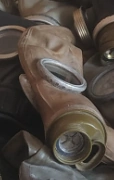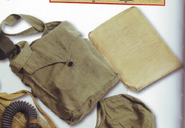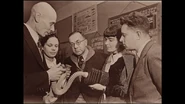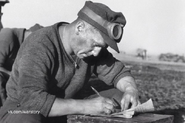The ShM-1 (Russian: Шлем Маска-1 - "Helmet Mask-1") was a Soviet mask intended for infantry use. The Hood Style dates back to World War I, pioneered as the Zelinsky Kummant, but it was based off of the ShMD-1 children's mask, which was introduced around 1938. It was introduced just before the Second World War, in 1939. The ShMD-1M children's gas mask is based on this mask and the O-11 faceblank is based off of this mask. The mask was chosen instead of the O-11 (similar to the O-8) because the hood layout was easier to use than a normal strap system and required less training for use. After the war, Hungary made a copy of the ShM-1, the 51M.
Mask overview[]
The facepiece is a helmet styled rubber mask. With two circular eyepieces in metal assemblies and Tissot-tubes system which are not integrated into the mask. The valves housing is made out of metal which is painted usually olive green or grey and has a 40mm GOST thread. There was a variant of the ShM-1 with a aluminium diecast valve similar to the GM30 valve. In 1942 the valve was redesigned to have a different exhale port. The exhale valve is a tulip type, however instead of 3 rubber pieces it has 2. Because of the molded seat which puts it in place in the valve assembly. The ShM-1s valve assembly is glued to the faceblank, however, some ShM-1s had crimped valves. The ones with crimped ones have later post 1942 valves. The mask was made in 4 sizes, from 1939 till at least 1948. The ShM-1s rubber was either gray, black neoprene, recycled or brown (not to confuse with sunburnt gray ones). On the left or right below the lenses, there is a mold stamp (for example Ф53). On some ShM-1s its on the nape of the mask, like on the 51M. An interesting thing to note is the resemblance to the later GP-5
Filters[]
T-5 filter[]
There's a small chance that ShM-1s were used with surplus T-5 filters. The T-5 filter was introduced in the 1920s with the TT-4, TT-S (updated version of the TT-4), Sh-1 and then later with the MOD O-8 in the BN T-5 kit.
They stopped producing the T-5 in 1937. Early T-5s had no thread and different ridges on the side.
Then T-5s made in the early 1930s had a thread and different ridges. Around 1935? the T-5 was redesigned to have a shorter thread and different ridges on the side. It was checked for air tightness until at least 1942.
The T-5's protection capabilities were documented in the 1930s, multiple chemicals were tested.
- Chlorine 0,1% - 6 hours
- Phosgene 0,1% - 5 hours
- Chloropicrin 1,5 mg/l - 8 hours
T-Ch filter[]
The T-Ch was introduced in 1935, originally used with the O-8 and Sh-1 in the BN T-Ch kit. Early T-Ch's had an inlet valve at the top intake.
Later ones are missing this inlet valve. But later was used with the ShM-1 in the BN T-Ch kit. The T-Ch saw use till at least 1943.
Some T-Ch's were produced at the LMZ factory (Лысьвенский металлургический завод - Lysva Metal Plant). T-Ch's frequently have air tight check stamps on them, filters were checked for air tightness until 1945.
MT-4 filter[]
The MT-4 was introduced in 1939 together with the ShM-1, in the BN MT-4 and BS MT-4 kit. The MT-4 stopped being produced in 1942 or 1943, but saw use at least till 1945.
There was also a SR MT-4 made at the same time as the MT-4, the only difference was the markings on the filter.
Some MT-4s were produced at the LMZ factory (Лысьвенский металлургический завод - Lysva Metal Plant). MT-4's frequently have air tight check stamps on them, filters were checked for air tightness until 1945.
L-2 filter[]
The L-2 was introduced sometime during the war, it was meant for tankers and aircrews.
It was based off of the MT-4.
Very few filters were made during the war.
L-3 filter[]
The L-3 was introduced in 1939, it was used by tank crews and aircrews in the BS L-3 kit. They stopped being produced around 1944.
MO-2 filter[]
The MO-2 was introduced in 1942, it was used with the BS MO-2 kit. The MO-2 stopped being produced somewhere around 1945, however the KR MO-2 was produced until the mid 1960s. After the war, MO-2s were refurbished and marked СР МО-2 (SR MO-2). After the war, there were also KR MO-2s and maybe SR MO-2's made, which were shorter then the original MO-2s.
MO-4 filter[]
After 1946 the ShM-1 was used with the MO-4 filter, not a lot is known about its production dates or discontinuation date. It was used in the MO-4 kit. There's a chance the ShM-1 was also used with the EO-12 in a unknown kit (RSh-4?), but no evidence of it exists as of now.
Bags[]
Obr.1936/M1936 and Obr.1938 bag[]
The M1936 bag is made of canvas. The M1936 bag has a pocket for the facepiece, then another pocket for the filter. On the inside there is a small pocket for an Anti-fogging stick. Then a pocket for the gas cape, on the outside there are 2 pockets for decontamination kits. The M1936 bag has a leather strap as its closing mechanism (later used on the Type A bag). The M1936 has two straps, one for around the shoulder and another one for the waist. The M1936 has a spring on the bottom for keeping the filter up right so its intake wouldn't close, instead of wooden blocks like on the M1940.
The Obr.1938 bag is identical to the Obr.1936, except the 1938 has no side pockets.
Obr.1940/M1940 and Obr.1941/M1941 bag[]
The M1940 bag is made of canvas (like with the later bags, they came in multiple colors). The M1940 has a pocket for the facepiece, then another pocket for the filter, then a pocket for a hose or a gas cape. On the inside there is a small pocket for an Anti-fogging stick. The M1940 has a single strap for around the shoulder. There are 2 wooden blocks on the bag bottom for keeping the filter up right so its intake wouldn't close. The M1941 is identical to the M1940 but has wooden hardware to save materials and has a waist strap.
Economy bags[]
Both the M1936 and M1940 had economy variants, these tend to be of lower quality and don't have some of the pouches (the M1936 economy bags have no gas cape pouch or side pockets, some call them M1939). Economy M1928 and M1931 bags might have been also used with the ShM-1. But no period or kit proof has been found.
Accessories[]
TD-1 individual decontamination kit[]
The TD-1 was the first individual decontamination kit used with the Mod O-8 and ShM-1 in the BT T-4 kit and the BN MT-4 kit. It was introduced somewhere in the mid 1930s and discontinued around 1939.
Contents[]
- Cardboard box
- Gauze balls
- Ampule with medicine
- Gauze piece
- Wedge for ball piercing
Instructions[]
Use of the ball. - Take the ball, squeeze it tightly in a handful, holding over the poisoned part of the skin. Press the center of the ball with your fingertips to push the container inside. If this fails, the container must be pierced from the side with a wedge of metal. Carefully and quickly (2-3 times) wipe the poisoned area with a compressed wet ball, then break the thread with which the ball is sewn to the side, wrap the gauze, remove the remnants of the container and wipe the poisoned spot with the gauze until the gauze dries. Each contaminated site should be treated in 2-3 minutes; if the gauze dries before this time (usually after 1-1/2 minutes), take another ball and apply in the same way. The liquid should not be rubbed into the skin, but only gently and thoroughly, with light movements sweep the contaminated area. Under no circumstances should the eyes be swept with balls; when wiping the skin of the face, make sure that the liquid does not get into the eyes.
IPP-3 individual decontamination kit[]
In 1941 the IPP-3 was introduced, it was possibly only made in 1941. There were 2 types of IPP-3s, ZA and VA. Lots of them were dumped by the soldiers, some might have been used as containers for personal items by soldiers. Most of them are found in bad condition, without anything inside.
Contents[]
- Small metal canister
- 2 large ampules
- 4 small ampules
- Manual
IPHP-42 individual decontamination kit[]
In 1942 to save costs the IPHP-42 was introduced. The IPHP-42 was a simple cardboard box with decontamination materials, it was cheaper to produce then the IPP-3. Its unknown when it was discontinued.
IPP-5 individual decontamination kit[]
The IPP-5 was a simple tinted glass flask (very similar to the later IPP-8 ) with a number stamped on the base, not a lot is known about this decontamination kit. It was likely introduced during the Second World War. Its unknown when it was discontinued.
IPP-6 individual decontamination kit[]
The IPP-6 was a simple cloth bag with wipes. It might have been introduced in 1942, but that is unconfirmed. Its unknown when it was discontinued.
Contents[]
- Decontamination wipes
- Cloth bag with instructions
NP Anti-fogging inserts and Anti-fogging pencil[]
The NP Anti-fogging inserts replaced the Anti-fogging pencil somewhere around 1939. Early NP kits had no NP marking on the tin and sometimes had a factory stamp on the tin. Inside the kit were some inserts, a manual and a label with date and designation. NP Anti-fogging inserts were meant to be placed on the anti-fogging rings near the lenses. the Anti-fogging pencil would be applied by rubbing it in the lenses and then spreading it around with your finger.
Hoses[]
Not a lot is known about the hoses, the ShM-1 seemed to use 40mm GOST stockinette covered or rubber hoses. You can tell them apart from later hoses by looking the the female and male thread paint (usually gray or black) and by markings.
Gas cape[]
The gas cape was a paper sheet impregnated with albumin, it would be worn when gas was being dropped, mainly against blister agents. It could protect against sulphur mustard for 12-14 minutes. This is the hardest to find part of the kit and most BN kits didn't contain a gas cape.
Kits[]
BN T-Ch and BN MT-4 kit[]
BN T-Ch kit was introduced in 1935 with the MOD O-8 and BN MT-4 (боевой несекретный/boyeboy nesekretny meaning 'combat unclassified') kits was introduced in 1939 together with the BS MT-4 kit. They contained:
- ShM-1 facepiece
- T-Ch filter or MT-4 filter
- M1936 bag
- 40mm stockinette GOST hose or 40mm rubber GOST hose
- NP Anti-fogging inserts or Anti-fogging pencil
- TD-1/IPP-3/IPHP-42/IPP-5/IPP-6 decontamination kit
- Gas cape
BS MT-4, BS L-3 and BS MO-2 kit[]
The BS MT-4, BS L-3 and BS MO-2 were the last kits to be issued in the Second World War. They contained:
- ShM-1 facepiece
- Economy M1936 bag, M1940/M1941 bag or Type A bag
- MT-4 filter, L-3 filter, MO-2 filter or MO-4 filter
- 40mm stockinette GOST hose or 40mm rubber GOST hose
- NP Anti-fogging inserts
MO-4 kit[]
The MO-4 kit was introduced around 1946. It contained:
- ShM-1 facepiece
- M1940/1941 bag or Type A bag
- MO-4 filter
- 40mm stockinette GOST hose or 40mm rubber GOST hose
- NP Anti-fogging inserts
- IPP-51 decontamination kit
Service[]
Soviet Union[]
The ShM-1 was issued mostly to infantrymen, however, the ShM-1 was used by aircrews and tankers with the BS L-3 kit. The ShM-1 saw use in the Second World War, but many soldiers dumped their masks. Because the mask was excess weight in their eyes. And luckily, soldiers didn't need masks on the eastern front. After the war, the masks were kept in storage. And around the 1960s, a program was launched to refurbish ShM-1s. ShM-1s from this program have replaced lens crimps and a ShM-41m valve assembly and are size 4. There are also refurbished ShM-1s with only new lens crimps and post 1942 ShM-1 valve, these ones are in all sizes and have a different type of stamp.
Poland[]
Established in 1943 on the territory of the USSR, the first division of the Polish Army was equipped with ShM-1 masks. Official documentation doesn't say anything about ShM-1 being used in Poland after the war, but in some archival videos from the Polish civil defense (TOPL), show the ShM-1 being used alongside the SzM-41, Maska typu cywilnego / Polish GP-4 and ML. Because of the lack of documents about any mask like this in polish archives, it's impossible to say if it was original soviet ShM-1 masks or the Poles copied it (however there has been an ShM-1 with a SzM-41 valve spotted in TOPL archival footage). The ShM-1 was used industrially in Poland as well, up until at least the 1960s.
Germany[]
During the war, some ShM-1s were captured by the Germans and sometimes were made into goggles. A similar technique was done to MOD O-8 and GM-30 masks.
Hungary[]
Hungary also used the ShM-1, during the war they captured some from the Soviets and added KÁB stamps (Központi Átvételi Bizottság - Central Acceptance Committee). They used the ShM-1 in the trials for the 44M buzogányvető. After the war a 48M was mentioned in numerous documents, there's a chance that it was a Hungarian issued ShM-1.[]
Yugoslavia[]
After 1945 the Yugoslavian Partisans (NOVJ-Narodnooslobodilačka vojska) later Yugoslavian Army (JA-Jugoslovenska armija) received military equipment from the Soviet Union. They received logistical vehicles, artilery, small arms and protective equipment. How many masks were delivered is unknown and when exactly that happened (<1948). The mask saw use along with the M3(M52), German masks of the era (GM38, GM30) and possibly even Italian equipment (this is just a logical assumption, they reused Italian helmets, possibly even gas masks (they had the same threading as the German ones), but currently there is no proof to backup these claims).
References[]
- Photos from the collection of Alexey Zolotarev (Алексей Золотарёв)
- The Soviet Soldier of World War Two by Philippe Rio
- Esi gatavs pretgaisa un ķīmiskai aizsardzībai (2nd edition, 1945)
- Tankönyv a vegyivédelmi tiszit hallgatók szaktechnikai oktatásához (1st part, 1972)
- http://www.gasmasklexikon.com/
- https://vk.com/@alte_gasmaske-protivogaz-l-2







































